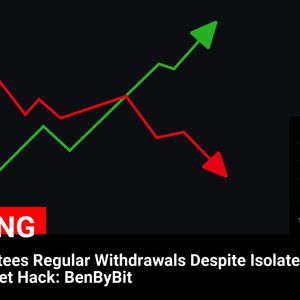Buckle up, crypto enthusiasts and Forex traders! All eyes are glued to the Reserve Bank of Australia (RBA) as they gear up for their first monetary policy announcement of 2025. Whispers in the market suggest a significant move – an anticipated RBA interest rate cut . But what does this mean for the Australian economy, the Australian Dollar , and your trading strategies? Let’s dive deep into the details and uncover what to expect. Decoding the Expected RBA Interest Rate Cut The financial world is buzzing with anticipation of a 25 basis points (bps) cut to the Official Cash Rate (OCR) by the RBA. After holding steady at 4.35% since November 2023, the pressure is mounting. Why the shift? Stubbornly high inflation and a slowing economy are pushing policymakers to act. But is this just the beginning of a series of cuts? Let’s break down the key factors influencing this pivotal decision: Easing Inflation: The good news is that Australian core inflation showed signs of cooling down in the last quarter of 2024. While still above the RBA’s target range, the deceleration is a crucial factor fueling rate cut expectations. The Trimmed Mean CPI, the RBA’s preferred inflation gauge, came in lower than anticipated, suggesting progress in taming price pressures. Economic Slowdown Concerns: Sluggish economic growth is becoming a major headache. The persistent high interest rates are squeezing households and businesses, impacting overall economic activity. A rate cut could be seen as a necessary stimulus to reignite growth. Strong Employment Data – A Complicating Factor: Here’s the twist – Australia’s employment growth remains robust. Annual employment growth actually strengthened, reaching its highest rate since October 2023. This positive employment data throws a wrench in the works, potentially making the RBA hesitant to aggressively cut rates. Australia Interest Rates : A Balancing Act for the RBA The RBA is walking a tightrope. They need to address the inflation issue, but they also can’t ignore the signs of economic slowdown. The December meeting minutes revealed a nuanced stance. While acknowledging eased upside inflation risks, officials also noted they were only “gaining some confidence” that inflation was moving towards the 2-3% target. Governor Michele Bullock herself highlighted that while rate cuts weren’t off the table, neither were rate hikes, emphasizing a cautious approach. Market sentiment currently leans towards a rate cut, but the prevailing expectation is that the RBA will proceed cautiously. This suggests a slow and measured approach to monetary easing rather than a rapid series of cuts. The RBA’s challenge lies in calibrating Australia interest rates to both manage inflation and support economic growth without triggering unwanted consequences. Monetary Policy Outlook : Clues from the RBA Announcement The real drama unfolds after the RBA interest rate cut announcement. The market’s reaction will heavily depend on the accompanying statement and Governor Bullock’s press conference. Traders and investors will be hanging on every word, searching for clues about the future monetary policy outlook . Key questions on everyone’s mind include: Is this a one-off cut, or the start of a easing cycle? The RBA’s forward guidance will be critical. Any hints of further cuts will have a significant impact. How concerned is the RBA about economic growth? The tone of the statement will reveal the RBA’s priorities – inflation control versus growth support. What are the RBA’s inflation forecasts? Updated forecasts will provide insights into the RBA’s confidence in achieving its inflation target. Australian Dollar (AUD/USD) : Navigating the Forex Seas How will the Australian Dollar (AUD/USD) pair react to the RBA’s decision? A 25 bps rate cut is largely priced in, so the immediate impact might be muted. However, the devil is in the details. Potential AUD/USD Scenarios: RBA Announcement Potential AUD/USD Reaction Explanation 25 bps cut, hawkish statement (hints at no further cuts soon) Potential AUD strength or limited weakness A “hawkish cut” could be interpreted positively as the RBA remains cautious about further easing. 25 bps cut, neutral statement Moderate AUD weakness Expected cut, limited surprise factor. 25 bps cut, dovish statement (hints at more cuts coming) Significant AUD weakness Signifies a shift towards a more aggressive easing cycle. 50 bps cut (unexpected) Sharp AUD sell-off A larger-than-expected cut would be a major dovish surprise. No rate cut (unexpected) Potential AUD spike Markets are heavily positioned for a cut, so no cut would be a hawkish surprise. Valeria Bednarik, Chief Analyst at Bitcoin World, notes the technical setup for AUD/USD: “The AUD/USD pair peaked at 0.6373 ahead of the announcement, its highest since mid-December. Technically, the pair has scope to extend its advance towards the 0.6470 region, but a dovish outcome could push it through the 0.6300 threshold.” She also highlights the uncertainty surrounding US tariffs and their potential impact on the Australian economy as a factor the RBA might consider. RBA FAQs: Understanding the Fundamentals Let’s clarify some key concepts related to the RBA and its influence on the Australian Dollar : What is the Reserve Bank of Australia and how does it influence the Australian Dollar? The RBA is Australia’s central bank, responsible for setting interest rates and managing monetary policy. Its primary goal is price stability (2-3% inflation), but it also aims to contribute to currency stability, full employment, and economic prosperity. Interest rate adjustments are its main tool – higher rates tend to strengthen the AUD, and lower rates weaken it. How does inflation data impact the value of the Australian Dollar? In modern finance, moderate inflation can actually be positive for a currency. It often leads central banks to raise interest rates, attracting foreign capital seeking higher returns. This increased demand strengthens the local currency, like the Aussie Dollar. How does economic data influence the value of the Australian Dollar? Strong economic data signals a healthy and growing economy, attracting investment. Indicators like GDP, PMIs, employment figures, and consumer sentiment can all impact the AUD. Positive data may encourage the RBA to raise rates, further supporting the currency. What is Quantitative Easing (QE) and how does it affect the Australian Dollar? QE is an unconventional tool used in crises. The RBA prints AUD to buy assets (usually bonds) from financial institutions, injecting liquidity. QE typically weakens the AUD. What is Quantitative tightening (QT) and how does it affect the Australian Dollar? QT is the reverse of QE, used during economic recovery to combat rising inflation. The RBA stops buying assets and reinvesting bond principal. QT is generally positive for the AUD. Economic Indicator: RBA Interest Rate Decision The RBA announces its interest rate decision after scheduled meetings. Hawkish stances and rate hikes are usually bullish for the AUD, while dovish views, unchanged rates, or cuts are bearish. Next Release: Tue Feb 18, 2025 03:30 GMT Frequency: Irregular Consensus: 4.1% Previous: 4.35% Source: Reserve Bank of Australia Disclaimer: Trading involves risk. Conduct thorough research before making any investment decisions. Recommended Content: Explore related articles for deeper insights. To learn more about the latest Forex market trends, explore our article on key developments shaping interest rates and institutional adoption.



















